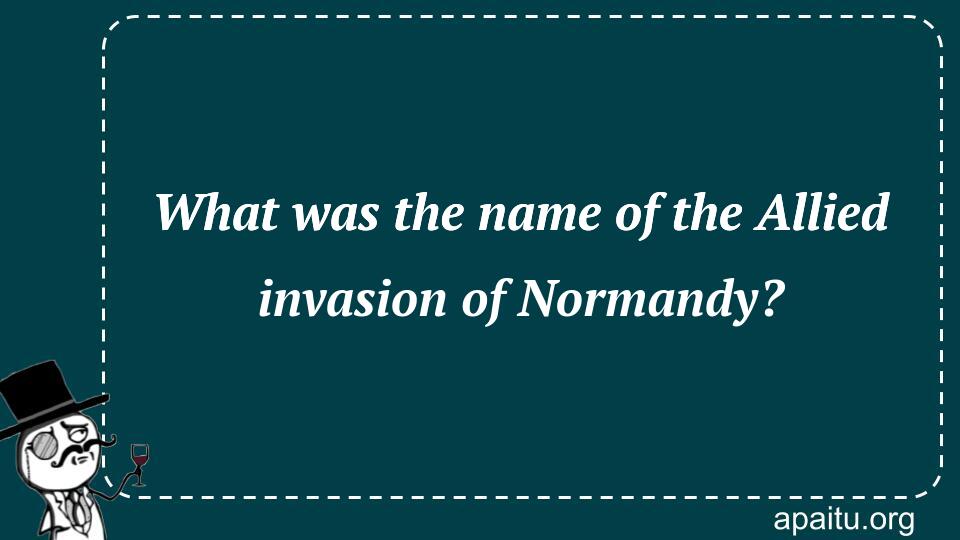Question
Here is the question : WHAT WAS THE NAME OF THE ALLIED INVASION OF NORMANDY?
Option
Here is the option for the question :
- Desert Storm
- Apollo 13
- D-Day
- Bay of Pigs
The Answer:
And, the answer for the the question is :
Explanation:
On June 6, 1944, D-Day, the start of the Allied invasion of German-occupied France via the beaches of Normandy, took place. By August of that year, the Allies had completely freed France from Nazi domination and were advancing into Germany from the west. The D-Day invasion was a crucial turning point in World War II and helped the Allies win the war in Europe.

D-Day is a term that holds significant historical importance, representing one of the most pivotal moments in World War II. It refers to the Allied invasion of Normandy, which took place on June 6, 1944. This massive military operation marked a turning point in the war, ultimately leading to the liberation of Western Europe from Nazi Germany’s control.
The planning and execution of the D-Day invasion were the result of meticulous coordination and collaborative efforts among the Allied forces. The invasion aimed to establish a foothold in German-occupied France and create a launching pad for subsequent offensives. The operation involved a multinational force consisting of American, British, Canadian, and other Allied troops, all working together towards a common objective.
The decision to launch the invasion on June 6, 1944, was based on numerous strategic considerations. The Allies sought to capitalize on favorable tidal and moonlight conditions that would facilitate the amphibious assault. Additionally, they aimed to surprise the German forces and secure a beachhead before the enemy could mount a significant defense.
The D-Day invasion consisted of airborne and amphibious assaults targeting five designated landing zones along the coast of Normandy. These landing zones were given code names: Utah Beach, Omaha Beach, Gold Beach, Juno Beach, and Sword Beach. Each beach had specific objectives assigned to different Allied divisions, with the overall goal of establishing a secure foothold on French soil.
The invasion itself was a massive logistical undertaking, involving an armada of over 5,000 ships and landing craft, along with thousands of aircraft. The airborne phase involved paratroopers and glider-borne troops being dropped behind enemy lines to disrupt German defenses and secure key objectives. The amphibious assault saw waves of infantry landing on the beaches and engaging in intense combat to establish control.
The D-Day invasion was met with fierce resistance from the German forces, who had fortified the coastline with bunkers, artillery, and mines. The landing forces faced heavy casualties, particularly at Omaha Beach, where the American troops encountered significant opposition. However, through bravery, determination, and the support of naval and air bombardment, the Allied forces were able to overcome the initial obstacles and gain a foothold on the beaches.
The success of the D-Day invasion laid the foundation for the subsequent liberation of Western Europe. The establishment of the beachhead allowed the Allied forces to bring in reinforcements, supplies, and equipment, enabling them to push inland and engage in a protracted campaign against the German forces. The invasion marked the beginning of the end for Nazi Germany’s control over Europe.
The significance of D-Day extends beyond its military impact. It symbolizes the bravery and sacrifice of the Allied forces and their unwavering commitment to freedom and democracy. The invasion represented a united front against tyranny, with soldiers from various nations coming together to fight for a common cause. D-Day stands as a testament to the resilience, courage, and determination of the men who stormed the beaches of Normandy and changed the course of history.
the D-Day invasion is commemorated and remembered as a milestone in World War II. The beaches of Normandy, where the landings took place, have become hallowed ground and sites of remembrance. Visitors from around the world pay tribute to the fallen soldiers and reflect on the significance of the operation that paved the way for the liberation of Europe.
D-Day represents the Allied invasion of Normandy on June 6, 1944, during World War II. This monumental military operation, involving a multinational force, aimed to establish a foothold in German-occupied France and initiate the liberation of Western Europe. The D-Day invasion marked a turning point in the war and stands as a testament to the bravery and sacrifice of the Allied forces. It is a reminder of the collective effort and determination that led to the ultimate defeat of Nazi Germany and the restoration of freedom and peace in Europe.